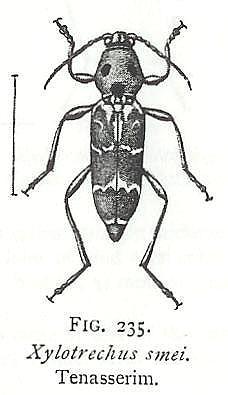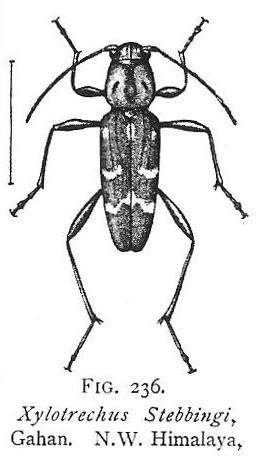Francesco Vitali, 2004d - Xylotrechus
smei (Castelnau & Gory, 1841), its
presence in Palaearctic region and description of the pupa (Coleoptera,
Cerambycidae) - Doriana VII (340):
1--7 ISSN 0417-9927 ![]()
The pupa of Xylotrechus smei (Laporte de Castelnau & Gory, 1841) is described, illustrated for the first time and compared with other West-European Xylotrechus-species.
The presence in Palaearctic of such widespread Oriental cerambycid is proved with biological, geographical and morphological characters.
(in English with Italian summary)
The species was misidentified by some Italian
authors as the Himalayan Xylotrechus stebbingi Gahan,
1906 . Nevertheless, Xylotrechus smei can be easily
distinguished .
According to the authors who really knew both species, they can
be separated as it follows:
Xylotrechus smei
Description (Gahan, 1906) -
Pronotum marked with 2 rounded dark brown spots on the disc and a
smaller one on each side; disc raised and subasperate along the
middle, here more or less infuscate, especially toward the base.
Elytra marked with 1 transverse band at the base;
1 short transverse spot behind; 1 narrow band that begins near
the scutellum, passes close to the suture, diverges posteriorly
and curves outwards before the middle; 1 transverse post-median
band ; 1 large apical band, produced forwards at the suture.
Hosts (Duffy, 1968) - 50 tropical
and Palaearctic broadleaf trees, among them Quercus, Ficus,
Gelsus, Vitis, Ailanthus.
Distribution (Duffy, 1968) - W-Pakistan
, India (Assam, Bhar, Madras, Maharashtra, Orissa, Punjab, Uttar
Pradesh, W-Bengal), Bhutan, Myanmar. Imported in Africa (Tanganyihka,
Zanzibar).
Now introduced in Mediterranean and North America .
Xylotrechus stebbingi
Description (Gahan, 1906) -
Pronotum with 4 small brown spots in a transverse row across the
middle; disc with a median asperate carina, which is broader and
more strongly raised behind than in front.
Elytra marked with some small spots which form 3
interrupted bands; apex very narrowly marked with ashy-grey.
Hosts (Duffy, 1968) - Monophagous
on Quercus fluribunda Lindl ex Camus (= Q.
dilatata Lindl. ex A. DC). Records for Q. lanata Sm.
in Rees (= Q. incana Roxb. n. n.) are due to
misidentification (Stebbing, 1914)
Distribution (Duffy, 1968) -
Himalayas
The drawings provided by Stebbing (1914 - Indian forest insects of economic importance - Eyre & Spottiswoode Ltd., London) are provided below:
 |
 |